Are you looking for the best solar-powered power stations for camping, vanlife, or other off-grid adventures? In the modern era, almost everyone has some kind of electronic device that they take camping. Whether it’s just a phone, headlamp, and camera, or glamping luxuries like a fridge, TV, or blender (frozen margaritas anyone?). This post shares the best portable solar-powered generators for off-grid camping and vanlife.
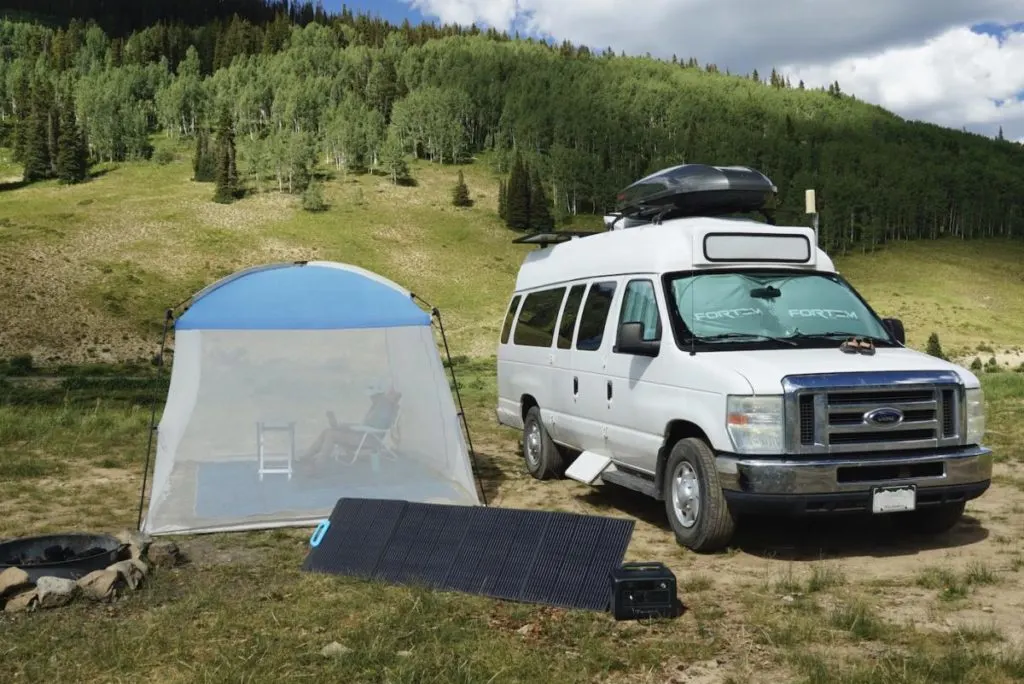
The sheer number of brands and models available is enough to make your head spin. But don’t worry this post narrows it down to the best highly-rated models to save you time.
Upgrading your camping setup with one of the best portable solar-powered generators can take your off-grid adventures to the next level. You can choose a small portable solar-powered generator with enough power to charge your small electronics multiple times. Or for serious power needs, upgrade to a larger battery that can power a TV, fridge, electric stovetop, or other higher-powered devices.
So having a portable solar-powered generator for off-grid vanlife & camping can be just what you need to enjoy the great outdoors.
This post may contain affiliate links. Disclosure policy.
What Is A Portable Solar-Powered Generator?
A solar-powered generator (also called portable power station) is an all-in-one battery and charging hub that can be charged with solar panels (plus usually an AC wall outlet and cigarette lighter port).
They are popular for camping, RVs, campervans, overlanding, off-grid homes, emergency backup, and more.
Besides a battery, solar generators typically include a variety of DC charging ports and AC outlets.
With everything you need for off-grid power all in one package, they are a very simple plug-and-play power system.
In contrast to a typical wired off-grid electrical system, where all the separate solar components are wired together to create the system. The expertise required to safely and correctly install a wired system is what steers many beginners to the simplicity of portable solar-powered generators.
Here’s our advice on choosing between a portable power station or DIY wired electrical system for vanlife.
Benefits of Portable Solar-Powered Generators:
- Plug-and-play
- Portable
- Rechargeable with renewable energy
- Can charge via Solar Energy, Wall Outlet, or Cigarette Outlet
- Nearly silent
- Portable solar panels can be directed at the sun
- Great for off-grid living
Cons of Portable Solar-Powered Generators:
- Expensive
- Less wattage per dollar (than a wired off-grid system)
- Limited expandability
Our Top Picks: Best Solar-Powered Generators
If you’re short on time and just want our top picks. Here are the best solar-powered generators for each tier.
Best For:
Minimal Device Charging: Anker 511 PowerHouse (87.6Wh, 90W)
Camping Trips: Bluetti EB3A (268Wh, 600W)
Glamping Luxuries: EcoFlow RIVER 2 Pro (762Wh, 800W) – (Bundle w/ 220W Solar)
Vanlife: EcoFlow Delta 2 Max (2016Wh, 2400W) – (Bundle w/ 660W Solar)
RV or Home Backup: EcoFlow DELTA Pro (3600Wh, 3600W)
Solar-Powered Generators vs Gas Generators
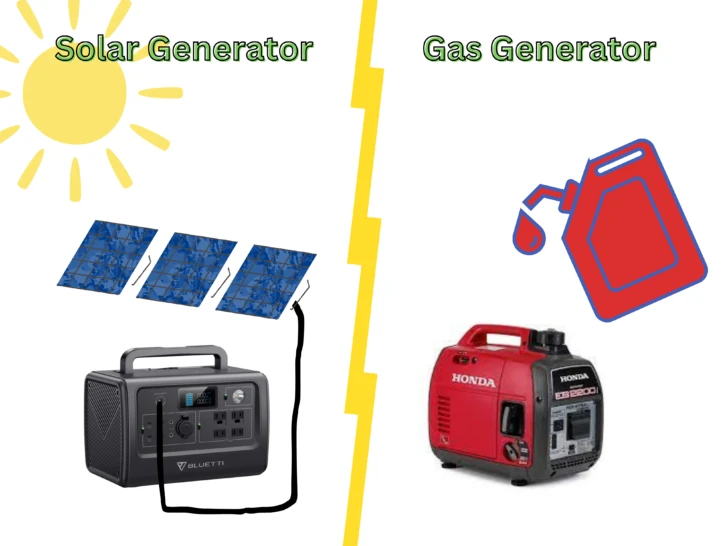
A solar-powered generator can often be confused with a gas generator.
Gas generators are the more traditional generators, powered by a gasoline engine.
Solar-powered generators are a combination of a rechargeable battery power station and (usually) a solar panel to charge said battery. Though, most of them can also recharge via an AC wall outlet or cigarette lighter port.
Gas generators burn fossil fuels and emit carbon dioxide, so they generally have to be outside and a safe distance from your living space. But solar generators are safe to have indoors.
When relying on strictly solar power, solar generators are limited by the available sunlight. So in cloudy or heavily shaded areas, gas generators are generally a better choice. But they are noisy and smelly to operate.
Solar-powered generators are an eco-friendly way of powering your off-grid adventure!
So there are definitely pros and cons for both.
Important Terms To Know
Before we get into the best Solar-Powered Generators, first, let’s define a few key terms you should know.
Alternating Current (AC): This describes the common power supplied by our power grid (in the US it’s 120Volt). Electrons flow back and forth quickly. It’s the type of current supplied by the normal outlets in a house. AC power is needed for things like TVs, blenders, power tools, coffee makers, and much more. Batteries are incapable of delivering AC power on their own, so most portable solar-powered generators have a built-in inverter to supply AC power.
Direct Current (DC): Direct current is the flow of electrons in a single direction, like from the negative battery terminal to the positive terminal. DC power is typically used for low-power consumption devices. For example phones, headlamps, camera batteries, fans, etc. The DC ports you are probably most familiar with are USB ports and cigarette lighter ports in car.
Watt (W): A common unit power, often used to quantify how much power a portable power station can deliver. Or how much power a device uses. Also notes the maximum rated capability of a solar panel.
Watt-hour (Wh): The measure of how many watts used per hour. This is commonly used to describe how much total power capacity a battery has.
Let’s use an analogy of trying to empty a bathtub. The Watt-hours are like the total volume of water in the bathtub. The Watt rating represents the size of your drain, and thus how much water you can release at any given instant.
Ampere hour (Amp hour or Ah): Amp-hours are very similar to Watt-hours in that they describe power over time.
But Amp-hours don’t factor in voltage, so they are generally less descriptive than Watt-hours.
To convert between Amp-Hours and Watt-Hours, the formula is:
[ Amp-Hours x Voltage = Watt-Hours ]
Or also useful to know [ Amps x Voltage = Watts ]
What Size Portable Solar-Powered Generator Do You Need?
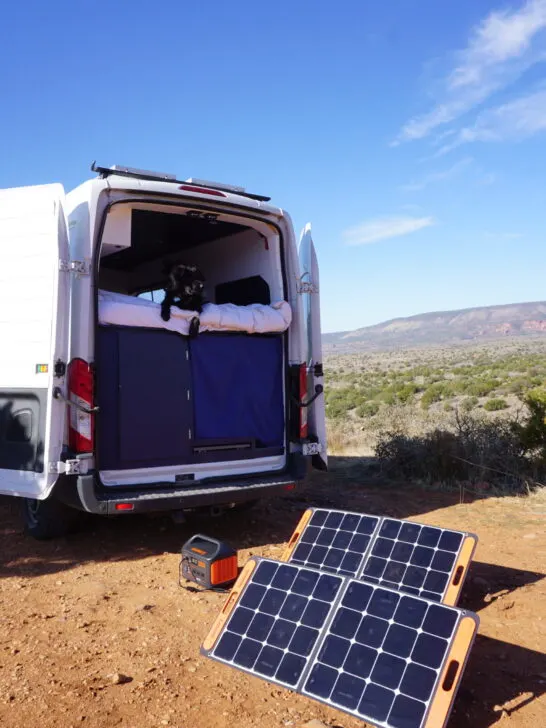
The main factor for choosing a solar-powered generator is total power capacity, usually measured in Watt-Hours.
But second in importance, is the maximum Watt rating of a solar-powered generator. This puts an upper limit on how much power the portable generator can deliver at any given moment. Typically this refers to the maximum power of the AC inverter (since DC ports are typically under 100W).
So, portable solar-powered generators are typically advertised with these two key metrics: Watt-Hours and Watts.
This allows you to compare the capability of similar portable solar-powered generators.
And these two metrics usually scale proportionally.
For example, a company might make a ‘Generator Pro: 1000Wh, 1500W’ and ‘Generator Mini: 350Wh, 400W’.
First, decide what you will be using a portable solar-powered generator for.
- Bare essentials device charging for camping trips or overlanding.
- Extra camping power for a luxury glamping setup.
- Main full-time power source for off-grid living or vanlife.
- Backup battery for emergency situations or a power outage.
With your desired use in mind, you can narrow in on a size of portable power station that is right for your needs. Namely, what kinds of things you want to power.
Generally, the more power they have the bigger and more expensive they are.
Common Solar-Powered Generator Watt-Hour Capacity Ranges:
200 Watt-Hours (or less):
A 200Wh battery (or less) is about as small as you should go for just a few small power needs. Batteries this size are typically called battery banks, rather than ‘generators’ or ‘power stations’.
Power banks are mainly used for charging phones, camera batteries, small electronics, headlamps, etc.
This size battery is best for backcountry travel, weekend warriors, or campers with minimal power needs. It’s generally very small and portable and thus could be carried into the backcountry (unlike pretty much all the larger batteries on this list. Despite what these companies’ marketing materials might suggest).
However, unless you really need a super small portable device, you get much better value from sizing up to a larger tier.
200-600 Watt-Hours:
A 200-600Wh battery is the next size up for off-grid travel. It will charge everything listed above, plus laptops (2-3 charges), small fans, etc.
This size battery is good for campers & vanlifers with still relatively small off-grid power needs. Or they can be the extra power you need for road trips. This size is good for people who have some smaller electronic devices to recharge and aren’t trying to run other “luxury” items continuously.
600-1000 Watt-Hours:
A 600-1000 Wh battery is a great size for the long-weekend camper who wants more power beyond the essentials (phones, cameras, etc) and include some of those extra glamping luxuries (coffee maker, electric blanket, blender, etc).
But you will still need to be quite selective about what you power. And a cloudy day or two will basically decimate your power supply (if you’re relying strictly on solar power).
This size could work for full-time vanlifers with minimalist power needs.
1000 Watt-Hours:
A 1000Wh battery station is finally getting into the range that can support full-time off-grid living. And for camping trips, it should have more than enough power for most glamping luxuries.
With this size you are getting into the range where you can power appliances full-time. For example, a 12v fridge powered 24/7 with few interruptions. LINK
But this size is still a little undersized for full-time living, especially in cloudy climates.
2000 Watt-Hours:
A 2000Wh battery power station is a perfect size for full-time off-grid vanlife. It can provide plenty of power for you to live comfortably with most of the standard vanlife ‘essentials’ (12v fridge, vent fan, lights, device charging, etc.).
You will be able to power many appliances daily and survive a day or two of cloudy weather.
It’s almost certainly overkill to bring on a camping trip. And it can be a solar backup generator for a smaller home.
This size typically allows the addition of expansion batteries if you want to add more storage capacity in the future.
3000 Watt-Hours And Above:
Once you get above about 3000Wh capacity, this enters the range of serious power supply for an off-grid cabin, tiny home, RV, or powering an entire home during a blackout.
Most power stations in this range are expandable, offering additional batteries that can be connected to greatly expand the power.
These units are very large and expensive, and calling them portable is a bit of a stretch. They are overkill for vanlife and camping.
They are typically used as a home backup with enough storage capacity to power household appliances.
How To Determine How Much Power You Need?
Most people are not familiar with how much electricity different devices and appliances use.
We just plug something into an outlet at home and it works, no more thought is required. It doesn’t matter whether something takes 5 watts or 500 watts. It just works.
But when you begin using power from limited sources like a portable power station, it’s in your best interest to learn how much power things use.
When choosing the right size portable solar generator the two things to pay attention to are the total Watt-hours you need, and what devices/appliances/tools might have the highest Watt rating.
For high AC-powered loads, you need an inverter with enough power to handle them.
AC Inverters are usually rated for continuous Watts and “surge Watts”. Continuous Wattage is the standard advertised rating that indicates the maximum power the inverter can provide over long periods of time.
But, inverters can usually handle a brief surge of extra power draw for a few seconds. The “surge power” rating accounts for devices that require extra power on start-up, and then settle back down to a lower continuous “operating” wattage.
This includes things with motors, like belt sanders, drills, and also sometimes microwaves, TVs, and more.
How To Calculate Watt Hours (Wh)
Multiply the amount of watts a device consumes by the amount of time you plan to use it.
Repeat this process for all the devices and appliances you plan to run, and then add them together.
Or if doing math scares you, try this helpful Watt-Hours Calculator to estimate how much power you need.
Just input the things you plan to power and the calculator takes care of the math for you. You can typically find a Watt rating on the device or its power supply. It’s usually listed in Watts or Amps/Voltage (remember Amps x Volts = Watts).
For example, here’s a list of things you may want to power.
- Recharge 1 cell phones [5W x 3 hours = 15Wh]
- DC fan (25W) for 15 hours per day [25W x 15 hours = 375Wh]
- Drip Coffee Maker [1000W x 10 minutes (0.167 hours) = 167 Wh]
15Wh + 375Wh + 167 Wh = 557Wh total
I recommend adding another 10-20% as a buffer. This should give you a rough idea of how much total wattage you need.
557Wh + 15% = 640.55Wh total
So you can see how different devices have vastly different effects on your power consumption. To recharge a cell phone at 15Wh is pretty minimal. But once you begin adding in “luxuries” like a drip coffee maker (167Wh), the impact is more substantial.
It’s also worth noting a key difference between the DC fan and the coffee maker. The fan only uses a minimal 25 watts compared to the coffee maker at 1000 watts. But since the coffee maker only needs to operate for 10 minutes per day, its overall Watt-hour consumption is less than the DC fan which you might run for hours to stay comfortable.
Another thing to be aware of is that some devices like compressor fridges cycle on and off, so they are not constantly running.
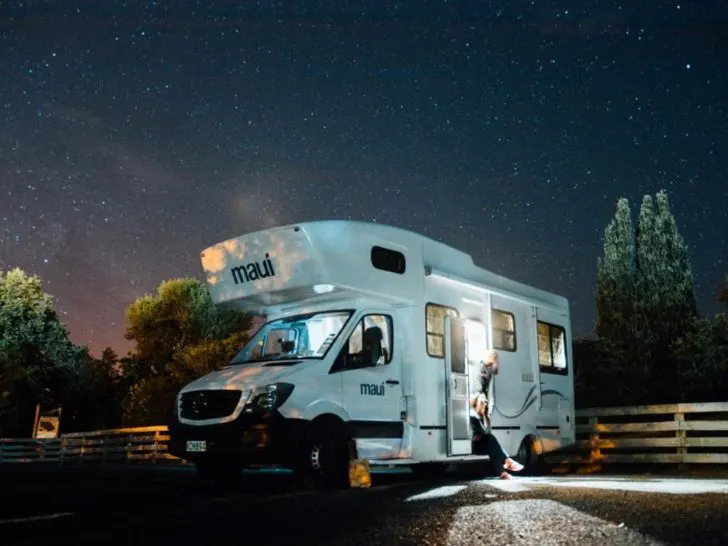
Usable Battery Capacity
It’s important to note that usable battery capacity is usually lower than the advertised (or nominal) battery capacity.
Some power is consumed by the LED screen, BMS (battery monitor system), and AC conversion loss.
So expect that most portable power stations deliver about 75-85% of the advertised Watt-hour capacity. To account for this, I recommend purchasing a portable solar-powered generator with about 25% more Wh capacity than you think you need.
Best Brands of Portable Solar-Powered Generators:
There is a large variety of established brands that all make great portable solar-powered generators. They are tried and tested brands that have thousands of (mostly) happy customers.
Some of the biggest names in the portable power station game are Bluetti, EcoFlow, Anker, Goal Zero, Jackery, and Renogy.
And there seems to be a constant stream of new brands that enter the space, offering competitive products. Some brands gaining popularity are Vtoman, Pecron, Titan, Inergy, BougeRV, Growatt, Dabbsson, Allpowers, and the list could go on forever.
But with various designs, specs, prices, and performance, it’s hard to pick a brand that wins every category at every battery size.
With portable power stations being so expensive, personally, we feel that it’s worth sticking to brands that have an established track record.
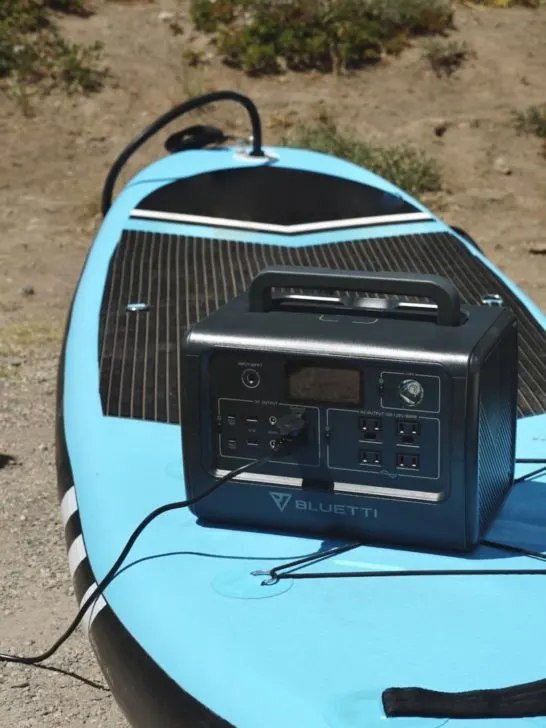
In 2023, the top-of-the-line brands that I recommend the most are Bluetti, EcoFlow, and Anker. They have been providing excellent products for years now, with features and specs that have an edge over the competition.
Currently, some of the best budget picks for portable solar-powered generators are Pecron and Vtoman. However, these brands don’t have quite the same track record as the brands mentioned above.
If there are two brands that are really in the ‘hot seat’, it’s Jackery and Goal Zero. At one time they were both pretty well established as the best products on the market. Made famous by the Goal Zero Yeti and Jackery Explorer lineups.
But in recent times they have lagged behind other brands. I’m not saying they make bad products, but simply that their prices are about the same or higher with less battery capacity and fewer features.
And, annoyingly, Jackery and Goal Zero use proprietary cables and connections for solar panels. Which forces customers into buying only their brand of solar panels, which are frankly overpriced for their performance.
But honestly, which portable solar generator you choose might come down to whichever is on sale when you are looking to buy. Seriously, it’s not uncommon to see insane deals, like 40% off or more. Which makes it really difficult to say definitively which solar generator is the best value.
And if you intend to charge with solar panels, brands often have special bundle pricing that includes solar panels.
So I would definitely shop around for deals among the best solar generators I’ve recommended.
Battery Chemistry: Lithium Iron Phosphate (LiFePo4 or LFP) vs Lithium NMC
The two most popular battery chemistries used in portable solar-powered generators are Lithium Iron Phosphate (LiFePo4) and Lithium NMC. These two different types of battery chemistry have some key differences.
The benefits of LiFePo4 are:
- ≈3x more discharge cycles (battery life)
- Safer and more stable, especially under large loads
The benefits of Lithium NMC are:
- More energy dense (smaller and lighter per Wh)
- Better in cold temperatures
The main takeaway from this is that LiFePo4 batteries are the best value for full-time off-grid users. When using your portable power station every day for years, the extra life cycles will matter a lot.
For the occasional camping trip or backup power source, the shorter life span of Lithium NMC may not be a huge factor. Since the battery will experience very few discharge cycles.
But here are some other less consequential tie-breakers.
If you are using the battery indoors and intend to run heavy loads, it favors the safer and more stable LFP chemistry.
For carrying your battery into the backcountry, a lighter NMC battery could be beneficial.
If you plan to use the battery in really cold climates, it favors NMC.
Which Brands Use Which Battery Chemistry?
As of October 2023, it generally breaks down like this.
LiFePo4 (Lithium Iron Phosphate):
Bluetti, EcoFlow, Anker, Vtoman, Pecron (both), Renogy (both), Jackery (both).
Lithium NMC:
Goal Zero, Inergy, Pecron (both), Renogy (both), Jackery (both).
Best Portable Solar-Powered Generators
Tiny (200Wh or less)
Don’t buy this category unless small size & portability are essential. You can get much better bang for your buck in the next tier.
Top Choice: Anker 511 PowerHouse (87.6Wh, 90W)
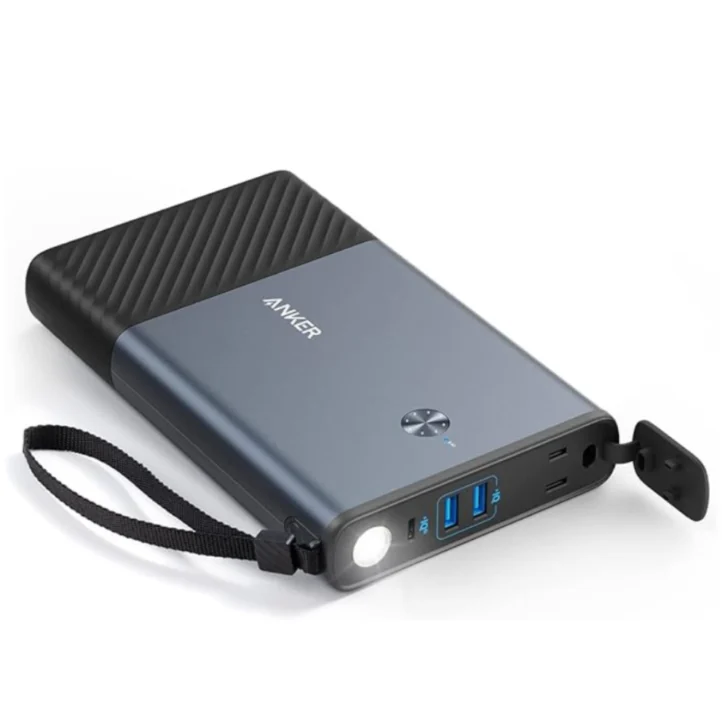
- An ultra-portable small powerbank
- Pure-Sine Wave AC is rare on a device this small
- Not ideal for solar charging (no charge controller)
Runner Up: Goal Zero Sherpa 100AC (95Wh, 100W)
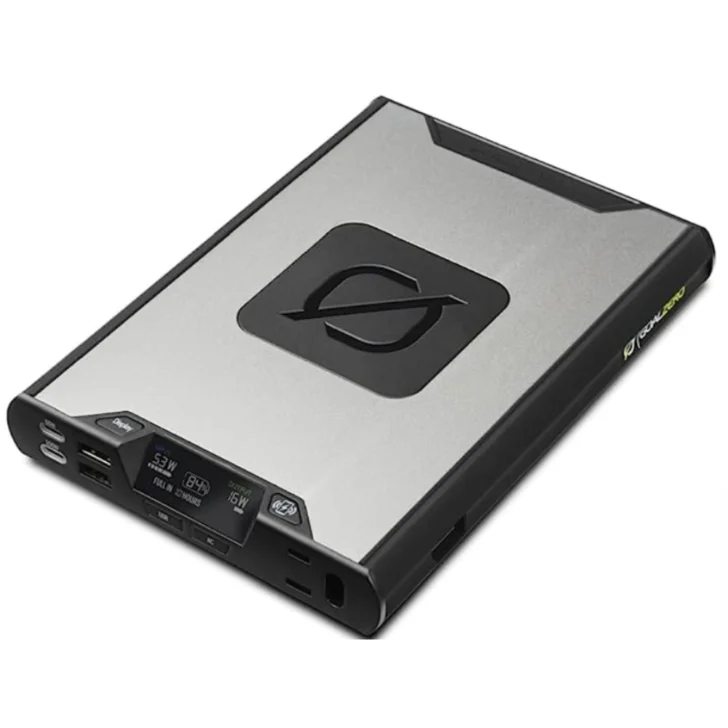
- More expensive than the Anker
- But more capacity and Inverter power
- Solar input management
- 15W Wireless charging pad
Small (200Wh – 600Wh)
Top Choice: Bluetti EB3A (268Wh, 600W)
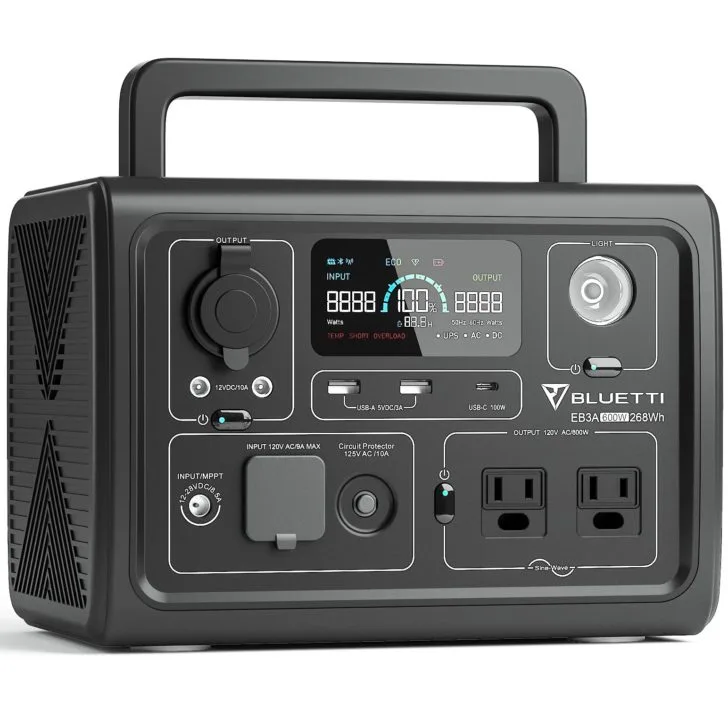
- Nearly double the Inverter Watt rating than similar models.
- Most features in its class
- 2-Year Warranty
Runner Up: EcoFlow RIVER 2 (256Wh, 300W)
- Bundle: River 2 + 110W Solar Panel
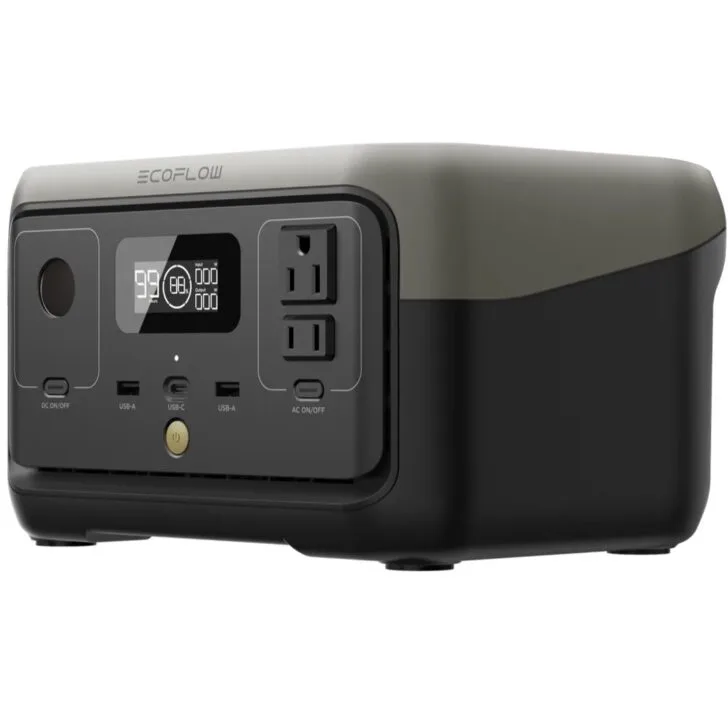
- 3 lbs lighter than the Bluetti EB3A
- 5-Year Warranty (best in the industry)
- Great option if you don’t need to power anything over 300W
Medium (600Wh – 1000Wh)
Top Choice: EcoFlow RIVER 2 Pro (762Wh, 800W)
- Bundle: River 2 Pro + 220W Solar Panel
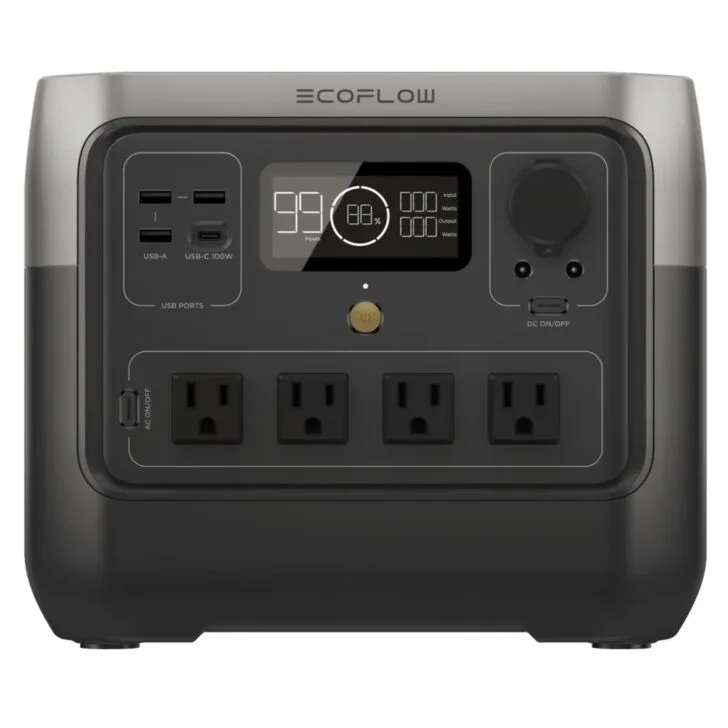
- 5-Year Warranty (best in the industry)
- Accepts 11-50V Solar Input (Nearly twice the Bluetti EB70S)
Runner Up: Bluetti EB 70S (716Wh, 800W)
- Bundle: Bluetti EB70S + 200W Solar Panel
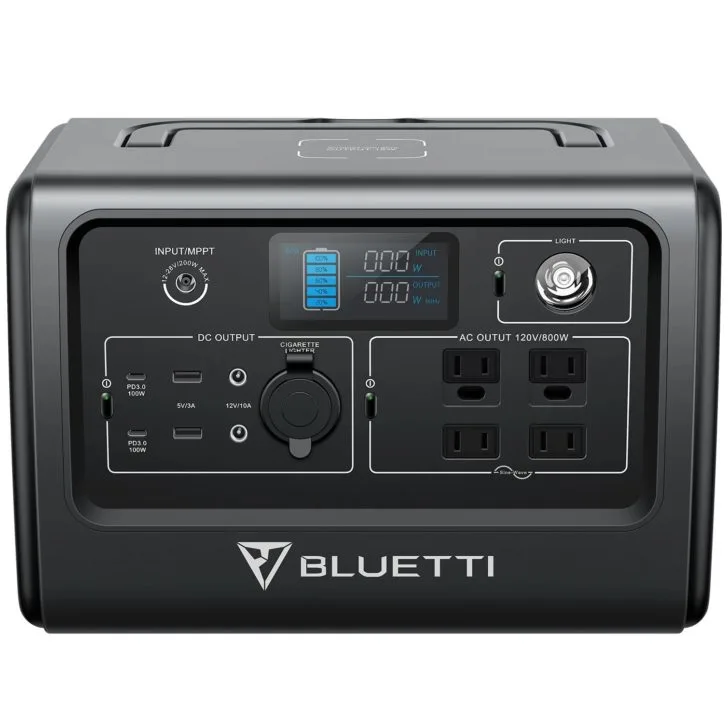
- Top variety of features
- 2-Year Warranty
- Read our in-depth review of the Bluetti EB70S
Budget Pick: PECRON E600LFP (614Wh, 1200W)
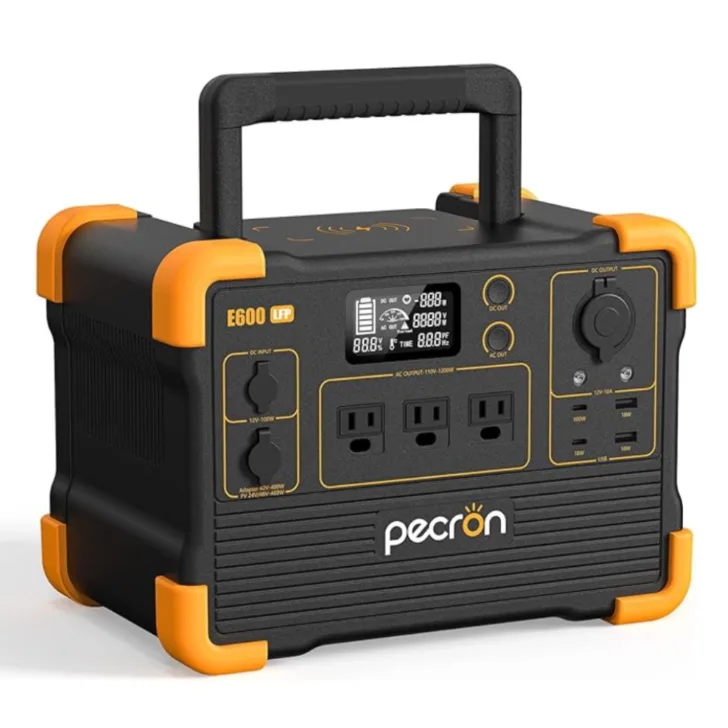
- Best price per Wh
- Excellent features
- Only 1-Year Warranty
Large (1000Wh – 2500Wh)
Top Choice: EcoFlow Delta 2 Max (2016Wh, 2400W)
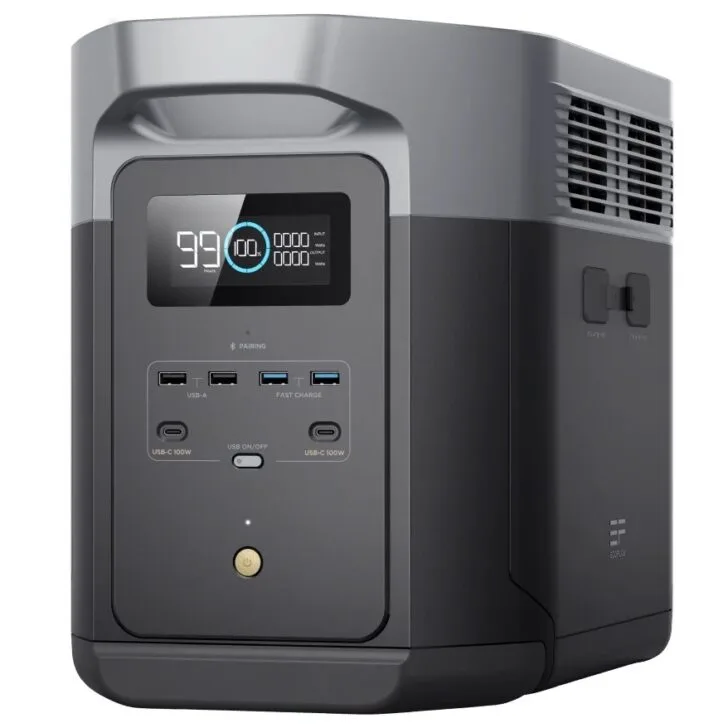
- Perfect option for full-time off-grid living
- Excellent build quality and features
- 50 lbs (11 lbs lighter than comparable Bluetti)
- 5-Year Warranty
Runner Up: Bluetti AC200Max (2048Wh, 2200W)
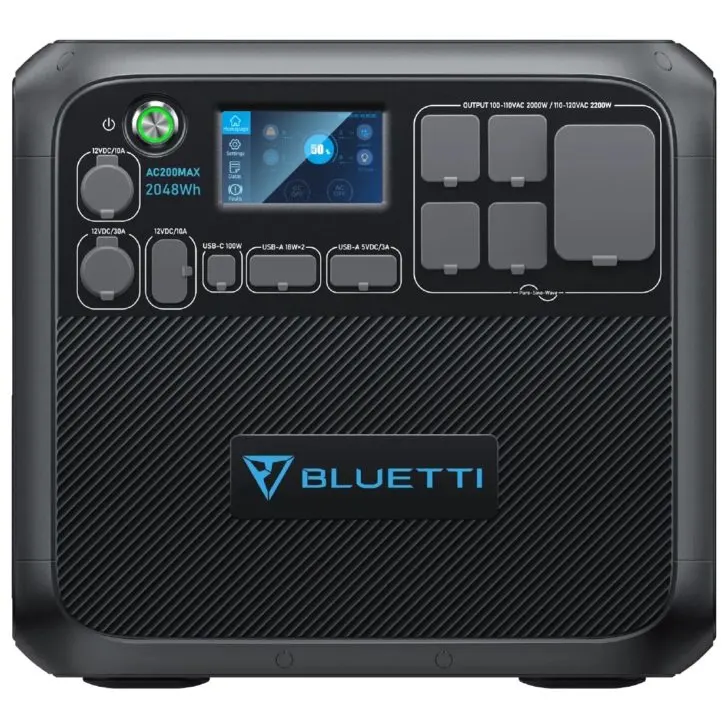
- Perfect option for full-time off-grid living
- Excellent build quality and features
- 61 lbs
- 4-Year Warranty
Runner Up: Anker Solix F2000 Powerhouse 767 (2048Wh, 2400W)
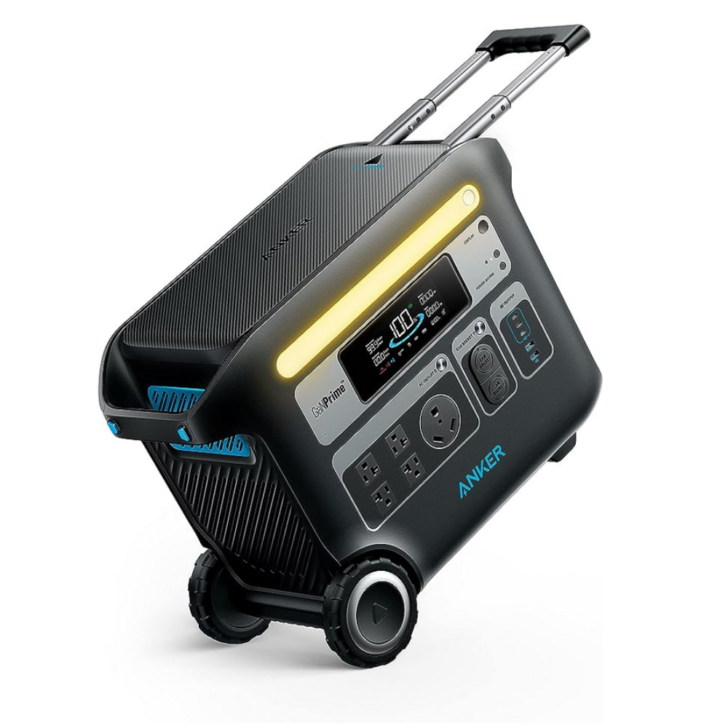
- Super powerful off-grid power source
- 5-Year Warranty
Budget Pick: Vtoman Jump 1000 (1408Wh, 1000W)
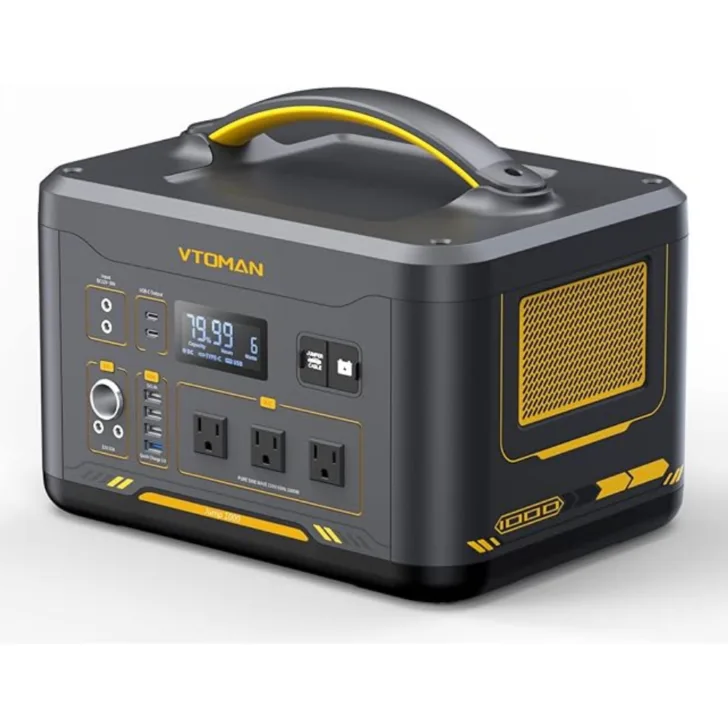
- Great power capacity for the price
- 1-Year Warranty
Budget Pick: PECRON E2000LFP (1920Wh, 2000W)
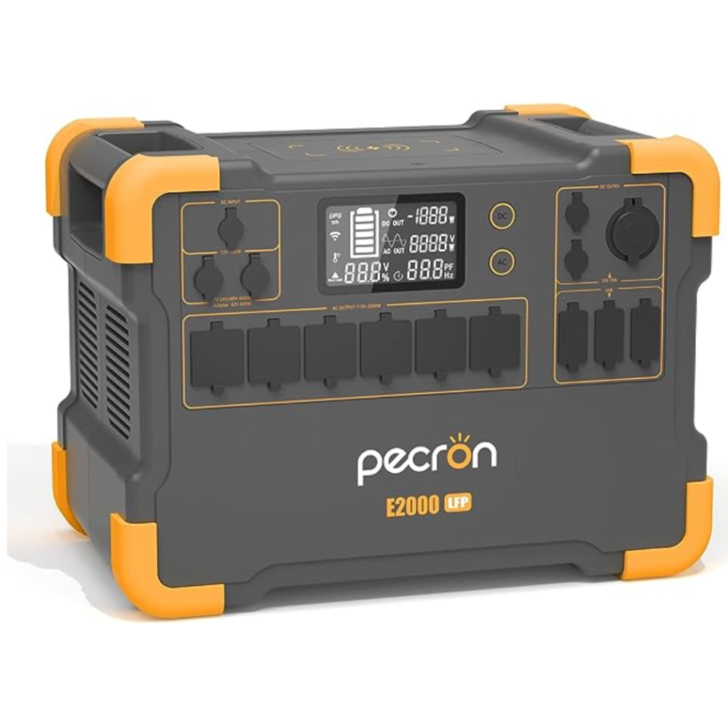
- Great power capacity for the price
- 1-Year Warranty
Extreme (2500Wh or More)
EcoFlow DELTA Pro (3600Wh, 3600W)
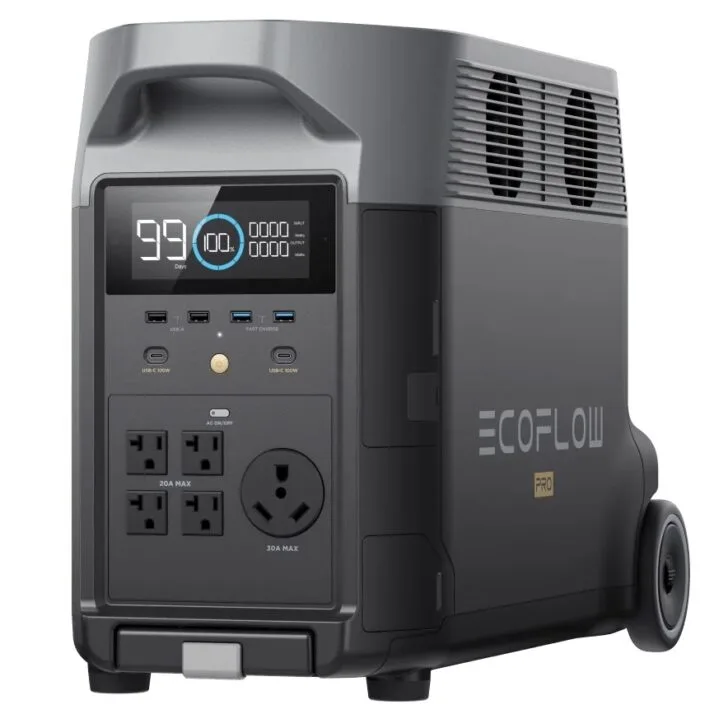
- 6500W recharge
- 3600W inverter output is best in class
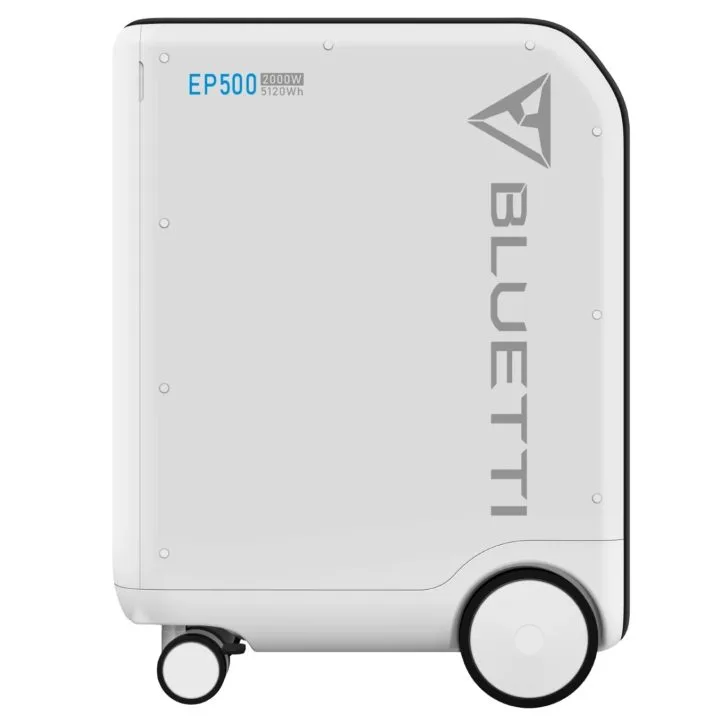
- In-grid UPS Mode&Flexible UPS Mode(24/7)
- App Remote Control
- 5-Year Warranty
Choosing Solar Panels For Your Solar Generator
All of these portable power stations can be charged via solar panels, AC outlet, or car outlet. But if you want renewable power off-grid, you will want a solar panel to supply the energy for your battery.
But how do you decide which solar panel to pair with your portable solar-powered battery?
Well, most brands have portable solar panels that they recommend with their portable power stations. But sometimes you can use third-party solar panels as well.
However, ‘brand name’ solar panels usually command a premium price, and don’t always perform better.
Portable Folding Panels vs Rigid Glass Solar Panels
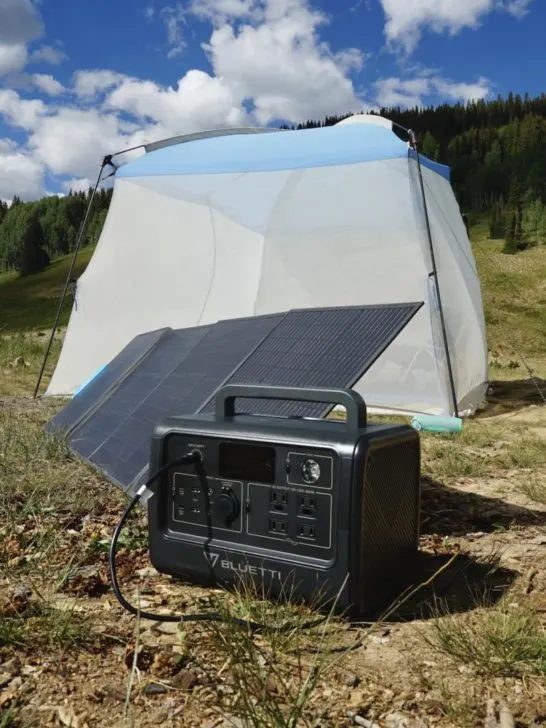
Portable solar panels are best for occasional use for camping or backcountry travel.
Conversely, rigid glass solar panels are ideal for a permanent mounting setup, like a campervan, RV, overlanding rig, or off-grid cabin.
The benefit of portable panels is that they are easier to place in an optimal location and angle towards the sun. And also track the sun throughout the day. Angle and sun exposure are very important factors for maximizing solar energy collection.
But you also have to set them up. And portable solar panels are typically less durable. The fabrics and coatings will wear out faster from UV damage and the elements.
Fixed panels are more of a set-it and forget-it solar installation. Rigid panels with an aluminum frame and glass coating are heavier than folding solar panels. But they are built to withstand being in the elements for decades. Rigid solar panels are a better value because they are less expensive per watt.
But fixed panels are usually mounted flat on your vehicle’s roof. And thus they don’t collect as much power when the sun is lower in the sky (morning, evening, and winter months).
See how I created a tilting solar panel on our campervan to angle at the sun.
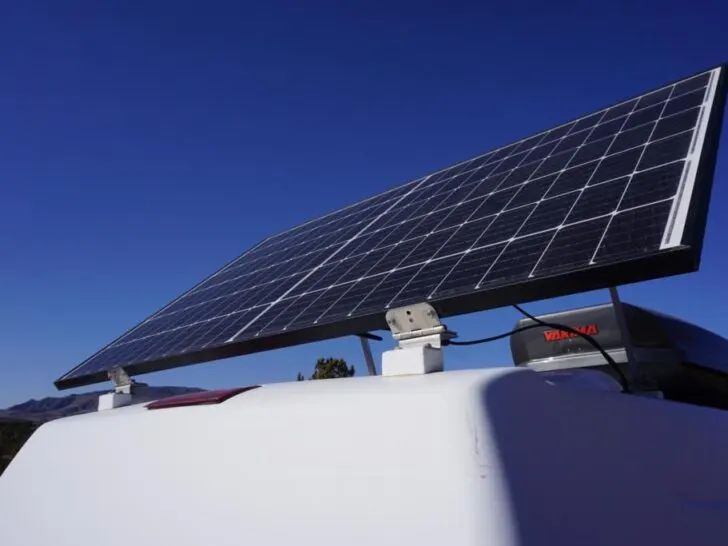
Sizing Your Solar Panel(s)
It’s important to choose a solar panel that is appropriate for the size of the battery.
If your panel is too small, you won’t be able to take advantage of your battery’s full capacity. If your solar panel is too big, it may exceed the input limits of your power station, or simply be more expensive than necessary.
The higher the solar panel wattage rating, the more power a panel can generate (and generally the bigger it is). So the total wattage of your panel will dictate how quickly you can recharge your batteries.
However solar generators often have a limit on solar input voltage. So you need to be sure that your solar panels do not exceed the maximum solar input voltage allowed. This is usually listed in the panel specs as Open-Circuit Voltage (or VOC).
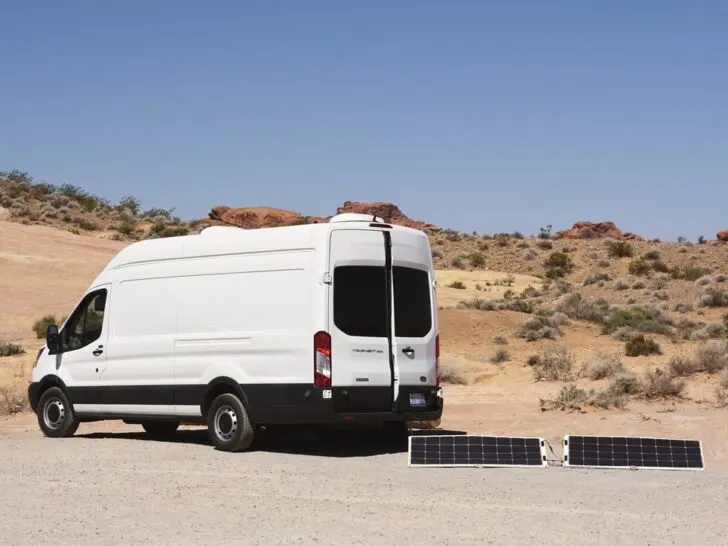
Tiny (100Wh or Less)
If you are getting a tiny portable battery bank (100Wh or less) a 50-60-watt solar panel will provide you with adequate charging power.
Small (100Wh or Less)
For small batteries between 200-600 watt-hours, you might choose between a slower charge via the 50-60 watt solar panels or get a faster charge with a 100-watt solar panel.
Medium (200Wh or Less)
For medium batteries between 500-1000 watt-hours, I would suggest a 200-watt solar panel.
Large (1000-2500Wh)
For large-sized batteries between 1000-2500 watt-hours, you should have at least 200-watts of solar panels. But 300-400 watts would be best for reliable daily charging.
Extreme (2500Wh +)
For extremely large batteries 2500 watt-hours and above, I recommend having a solar array between 600-1200 watts.
Most brands recommend solar panel pairings with their portable power stations. And generally, that makes it very easy to make sure your battery and panel are a good match.
And you are obviously more than welcome to just pair your solar generator with a solar panel from the same brand.
However, there could be some financial savings in choosing a third-party solar panel. Just make sure that it’s compatible with your specific power station. Check that the Open-Circuit Voltage (VOC) is within the range of the solar input voltage your power station accepts. And verify that you have the right cables and connectors to connect them.
Best Solar Panels For a Portable Solar-Powered Generator
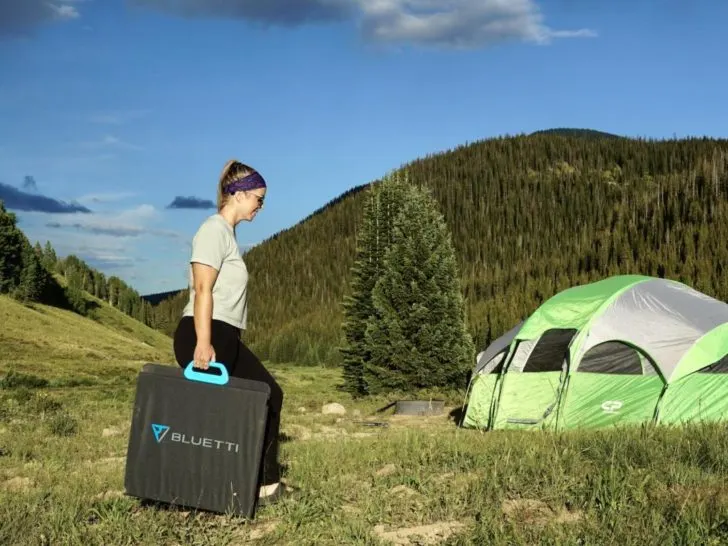
Here’s a quick breakdown of the best brands of solar panels. Again, it’s hard to pick a clear winner in every category because they vary in price per watt, performance, durability, warranty, etc.
And as I mentioned before, Jackery and Goal Zero use proprietary connectors, so you are basically forced into buying the same brand if you go with them.
Pretty consistently, the brand Allpowers offers a really great value in terms of price per watt. That’s because they are priced cheaper than many of the ‘name brand’ panels. However, they typically don’t produce as many watts per square foot.
So with the name brand panels, you might see better efficiency from the panels, but pay a premium price for that performance.
And one brand that stands out negatively from a usability perspective is EcoFlow. Their solar panel design uses the case as the kickstand, and it is incredibly annoying to set up. For that reason alone, I might consider avoiding their panels. Otherwise, they are excellent panels in terms of efficiency.
So you can just decide what your priorities are when purchasing a portable solar panel.
Here are links to some of the best brand-name and third-party solar panels in each tier. These are chosen for their overall combination of price, features, and efficiency. I got these choices from Jasonoid on Youtube, who does excellent head-to-head solar panel testing videos.
We live in our campervan full-time so storing and testing solar panels is not really feasible for our lifestyle.
50-60 Watt Solar Panels
Top Choice: Rockpals 60W Solar Panel – Efficient folding solar panel with adjustable kickstands.
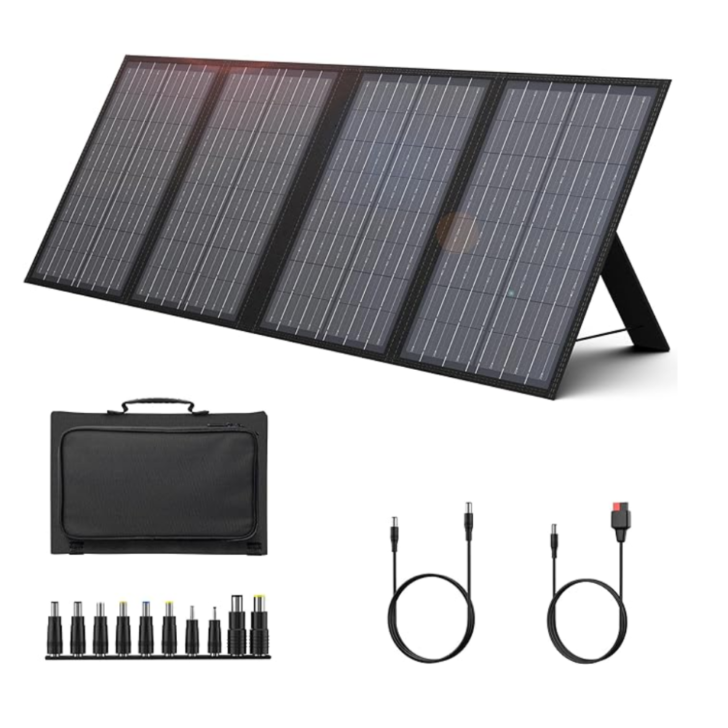
Ultralight Choice: Sunpower 50W – Super lightweight and affordable. But it lacks any kind of kickstand.
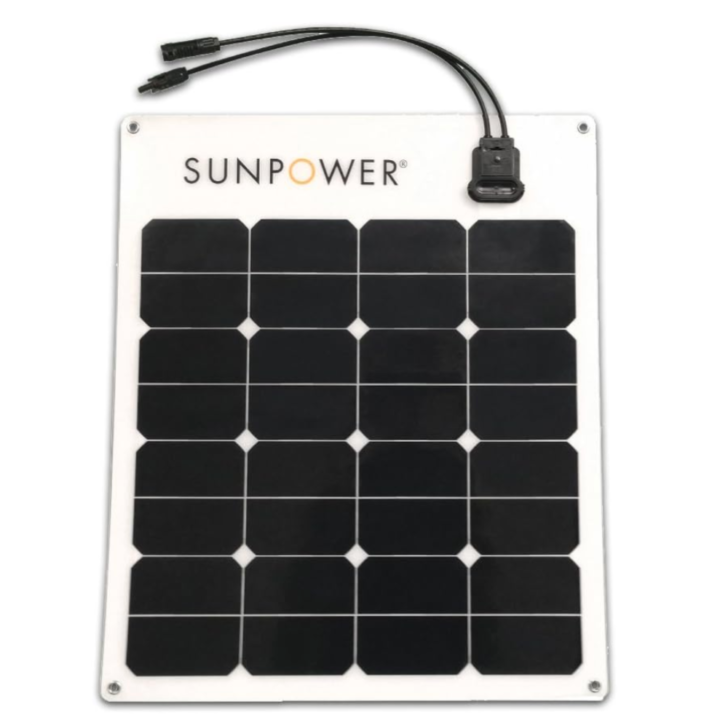
100-Watt Solar Panels
Top Choice: Baldr 120W – Efficient folding solar panel with adjustable kickstands.
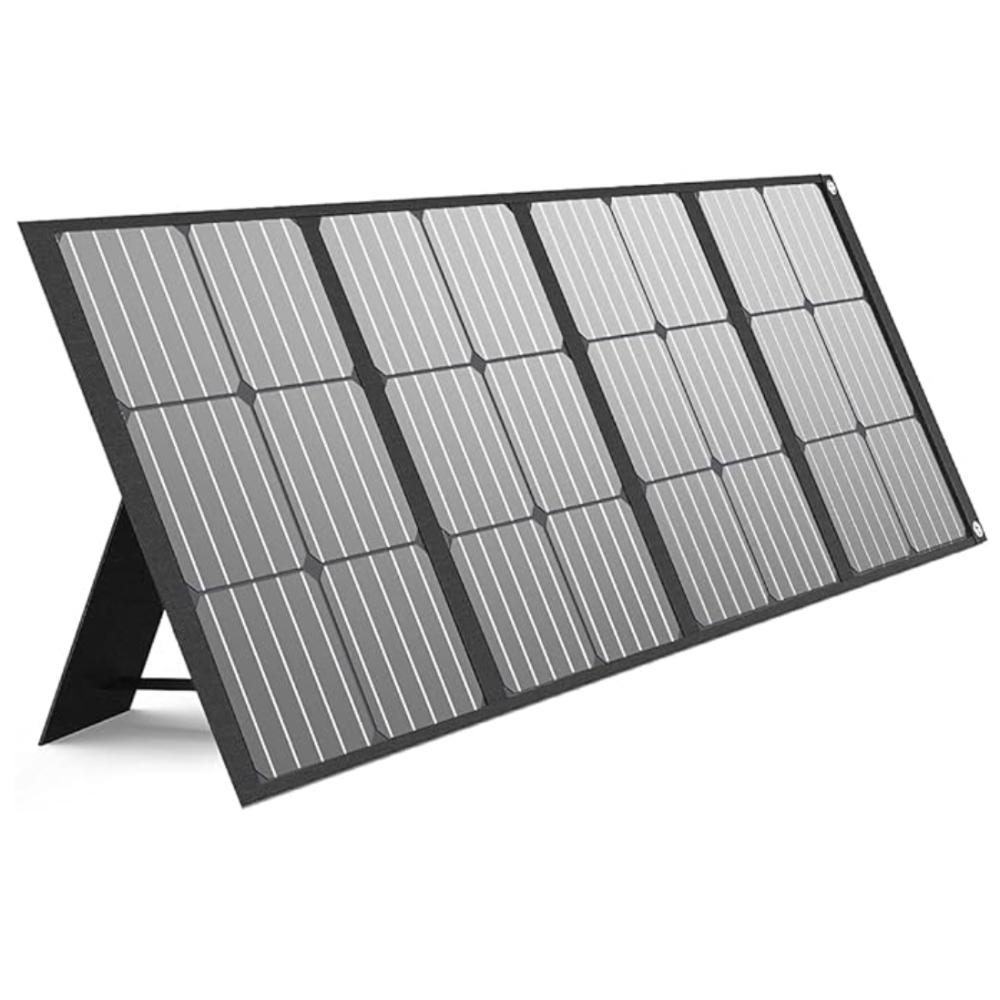
Runner Up Panels: Elecaenta 120W & Dokio 110W
Best Rigid Panel: RichSolar 100W Solar Panel
200-Watt Solar Panels
Top Choice: Allpowers 200W – Best all around 200W Solar Panel.
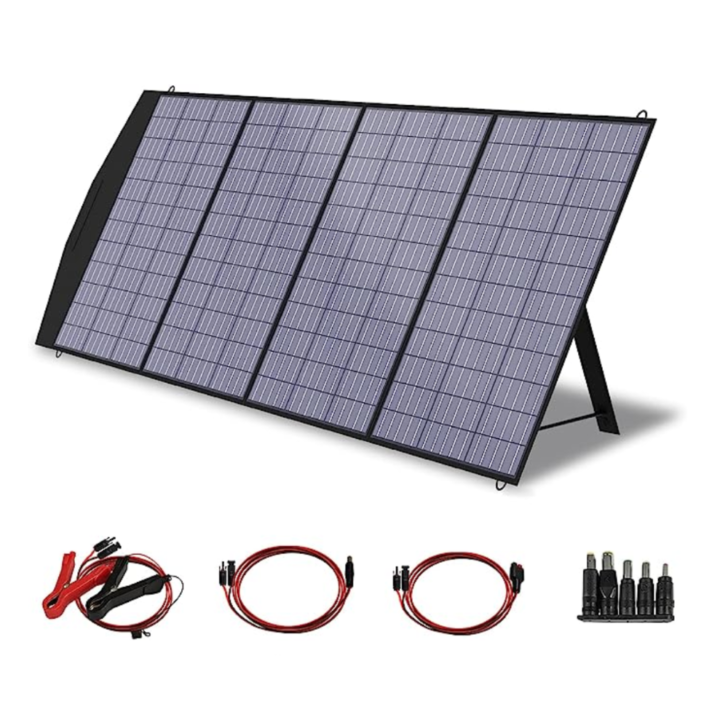
Most Efficient: VCUtech 200W = Most efficient but bad in partial shading
Runner Up: Bluetti 200W – A great ‘name brand’ folding solar panel.
Best Rigid Panel: RichSolar 200W Solar Panel
400-Watt Solar Panels
Top Choice: Allpowers 400W – Best all around 400W panel for the money.
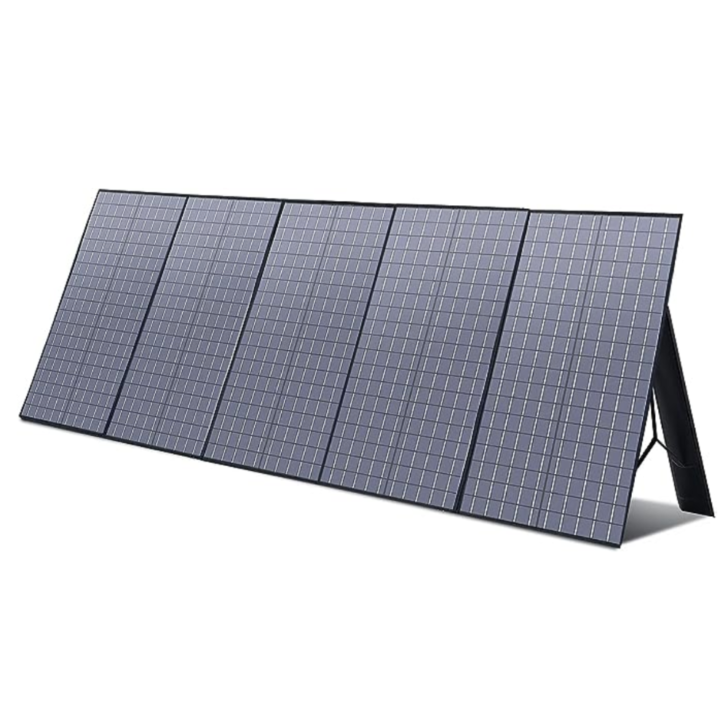
Runner Up: Bluetti 420W – A great ‘name brand’ folding solar panel.
Related Posts
A portable solar-powered generator is a good choice when portability is essential. However, the alternative for off-grid power solutions is a wired solar setup. Read out my guide to solar components for a wired solar setup.
Or maybe you are considering doing Vanlife or camping without solar power.
Read our in-depth Bluetti EB70S Portable Solar-Powered Generator Review.
Visit our Vanlife Solar Shop for all the best products we recommend.
Save The ‘Best Portable Solar-Powered Generators For Vanlife & Camping’ On Pinterest!
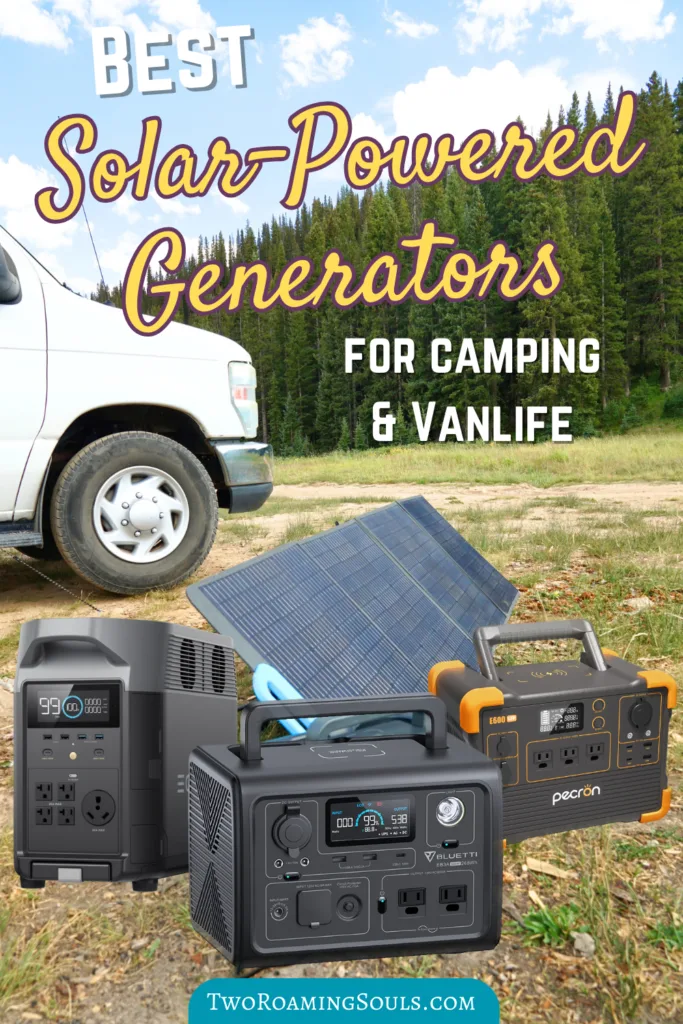
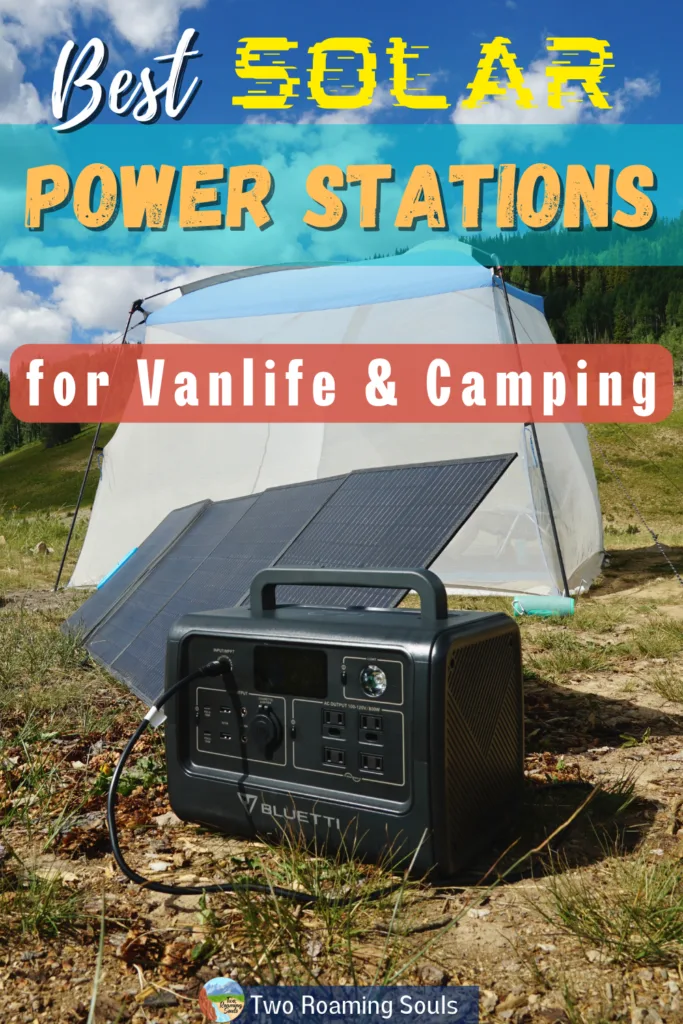

How Much Does It Cost To Convert A Campervan - tworoamingsouls
Sunday 16th of April 2023
[…] items to include a bed, vent fan, storage, cheap fridge or cooler, camp stove, and maybe a solar-powered generator and simple kitchen sink with a foot pump. The budget van conversion saves money with cheaper […]
Unexpected Problems You Deal With In Vanlife - tworoamingsouls
Wednesday 5th of April 2023
[…] Best Portable Solar-Powered Generators For Off-Grid Camping & Vanlife […]
Best Portable Showers For Vanlife & Camping - tworoamingsouls
Tuesday 4th of April 2023
[…] water can be heated by plugging in to any 12DC socket, a portable power station or […]
Ultimate Camper Van Hacks To Make Vanlife Easier - tworoamingsouls
Friday 10th of February 2023
[…] the winter months or if you just don’t have a large battery supply, a camper van hack is to get a portable solar generator. This will make vanlife easier, because when you don’t want to drain your batteries, you have a […]
25 Of The Best Camper Van Accessories - tworoamingsouls
Friday 8th of October 2021
[…] Portable batteries come in all sizes and power supply, so follow this guide for the best portable battery to fit your needs. […]